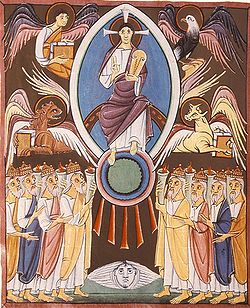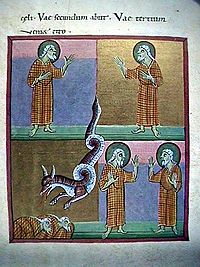
Bamberg Apocalypse
Encyclopedia

Illuminated manuscript
An illuminated manuscript is a manuscript in which the text is supplemented by the addition of decoration, such as decorated initials, borders and miniature illustrations...
manuscript
Manuscript
A manuscript or handwrite is written information that has been manually created by someone or some people, such as a hand-written letter, as opposed to being printed or reproduced some other way...
containing the Book of Revelation
Book of Revelation
The Book of Revelation is the final book of the New Testament. The title came into usage from the first word of the book in Koine Greek: apokalupsis, meaning "unveiling" or "revelation"...
and a Gospel
Gospel
A gospel is an account, often written, that describes the life of Jesus of Nazareth. In a more general sense the term "gospel" may refer to the good news message of the New Testament. It is primarily used in reference to the four canonical gospels of Matthew, Mark, Luke, and John...
Lectionary
Lectionary
A Lectionary is a book or listing that contains a collection of scripture readings appointed for Christian or Judaic worship on a given day or occasion.-History:...
.
It was created in the scriptorium
Scriptorium
Scriptorium, literally "a place for writing", is commonly used to refer to a room in medieval European monasteries devoted to the copying of manuscripts by monastic scribes...
at Reichenau
Reichenau Island
Reichenau Island lies in Lake Constance in southern Germany, at approximately . It lies between Gnadensee and Untersee, two parts of Lake Constance, almost due west of the city of Konstanz. The island is connected to the mainland by a causeway that was completed in 1838...
between 1000 and 1020 and is closely related to other Reichenau manuscripts including the Pericopes of Henry II
Pericopes of Henry II
The Pericopes of Henry II is a luxurious medieval illuminated manuscript made for Henry II, the last Ottonian Holy Roman Emperor, made c. 1002 – 1012 AD...
and the Munich Gospels of Otto III.
It was commissioned by Otto III
Otto III, Holy Roman Emperor
Otto III , a King of Germany, was the fourth ruler of the Saxon or Ottonian dynasty of the Holy Roman Empire. He was elected King in 983 on the death of his father Otto II and was crowned Holy Roman Emperor in 996.-Early reign:...
. The manuscript was unfinished
Unfinished work
An unfinished work is creative work that has not been finished. Its creator may have chosen never to finish it or may have been prevented from doing so by circumstances outside of their control such as death. Such pieces are often the subject of speculation as to what the finished piece would have...
at the time of Otto's death and was ordered completed by Henry II
Henry II, Holy Roman Emperor
Henry II , also referred to as Saint Henry, Obl.S.B., was the fifth and last Holy Roman Emperor of the Ottonian dynasty, from his coronation in Rome in 1014 until his death a decade later. He was crowned King of the Germans in 1002 and King of Italy in 1004...
, who then, along with his wife, Cunigunde
Cunigunde of Luxemburg
Saint Cunigunde of Luxembourg, O.S.B. , also called Cunegundes and Cunegonda, was the wife of the Holy Roman Emperor Saint Henry II. She is the Patroness of Luxembourg; her feast day is 3 March....
, donated it to the newly established Collegiate Abbey of St. Stephan at Bamberg. It is the only extant illustrated Ottonian
Ottonian art
In pre-romanesque Germany, the prevailing style was what has come to be known as Ottonian art. With Ottonian architecture, it is a key component of the Ottonian Renaissance named for the emperors Otto I, Otto II, and Otto III...
Apocalypse
Apocalypse
An Apocalypse is a disclosure of something hidden from the majority of mankind in an era dominated by falsehood and misconception, i.e. the veil to be lifted. The Apocalypse of John is the Book of Revelation, the last book of the New Testament...
manuscript.

Bookbinding
Bookbinding is the process of physically assembling a book from a number of folded or unfolded sheets of paper or other material. It usually involves attaching covers to the resulting text-block.-Origins of the book:...
s and is illuminated with 57 gilded miniatures
Miniature (illuminated manuscript)
The word miniature, derived from the Latin minium, red lead, is a picture in an ancient or medieval illuminated manuscript; the simple decoration of the early codices having been miniated or delineated with that pigment...
and over 100 gilded initial
Initial
In a written or published work, an initial is a letter at the beginning of a work, a chapter, or a paragraph that is larger than the rest of the text. The word is derived from the Latin initialis, which means standing at the beginning...
s. In 2003 it, along with other Ottonian manuscripts produced at Reichenau, was added to the UNESCO
UNESCO
The United Nations Educational, Scientific and Cultural Organization is a specialized agency of the United Nations...
Memory of the World International Register.

